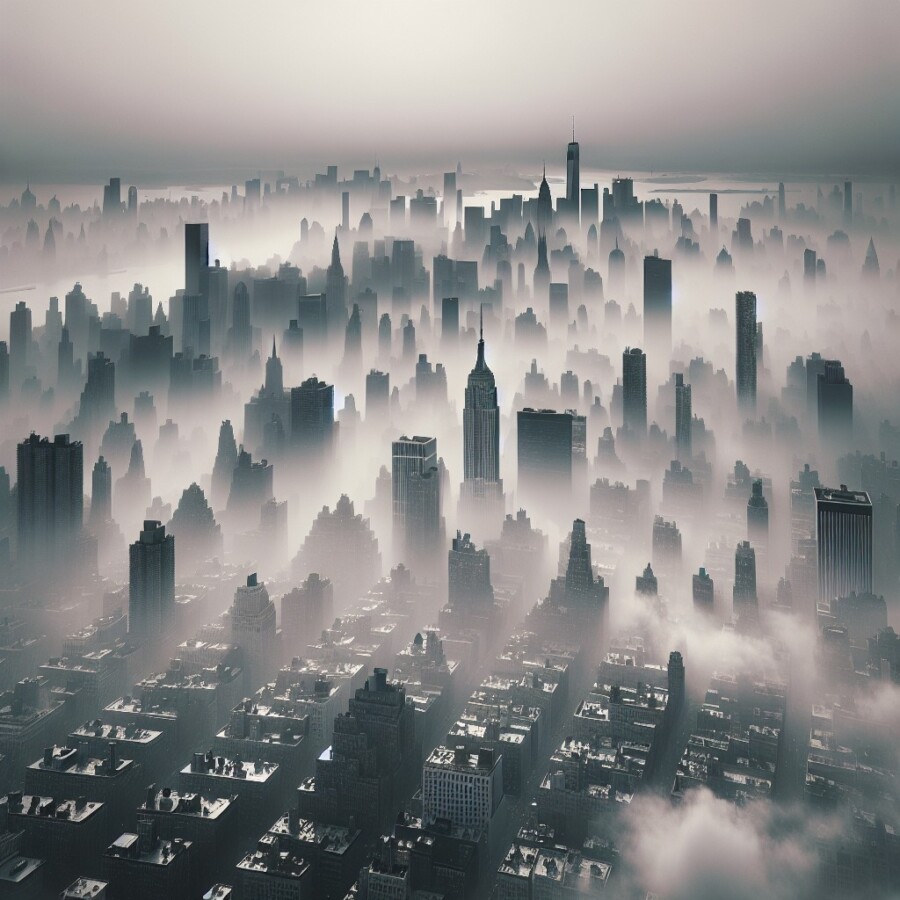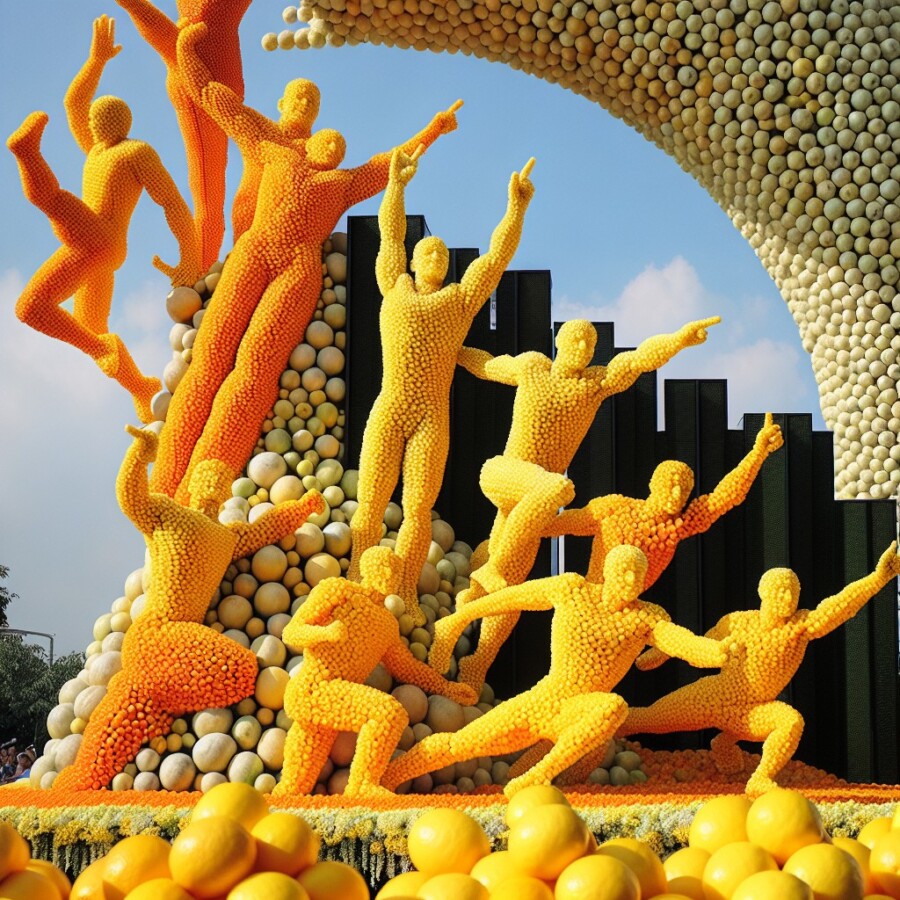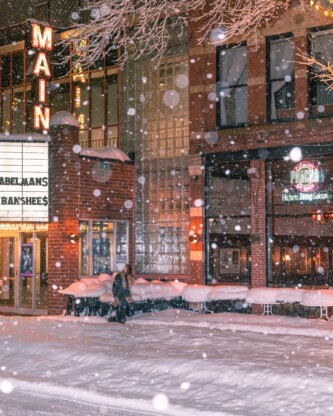On Tuesday morning, New York City was covered in a very thick fog. This made the city look like it was floating in the clouds. The fog came because the wind blew over cold water and then moved over the city. This kind of fog is called “advection fog.” It happened because the wind was blowing a certain way and the water was cold.
The fog made it hard to see the big buildings in the city. It was like a dream. Because of the fog, people driving cars had to be very careful. But, some people thought the fog made the city look special and pretty. This kind of fog happens a lot near the ocean, especially when the weather starts to get warm but the water is still cold. It can make things look beautiful but also make it hard to go places or do things outside.
Original news source: Dense fog transforms New York into a city on clouds (BBC)
🎧 Listen:
Slow
Normal
Fast
📖 Vocabulary:
| 1 | fog | A thick cloud close to the ground that makes it hard to see |
| 2 | floating | Staying up in the air or on top of water without falling |
| 3 | clouds | White, fluffy things in the sky |
| 4 | advection | A big word for a type of fog that moves because of the wind |
| 5 | dream | Something you see or think about when you sleep |
| 6 | careful | Being very safe and not getting hurt |
| 7 | special | Different and better than usual |
| 8 | ocean | A very big area of salt water |
| 9 | beautiful | Very pretty to look at |
| 10 | outside | Not inside a house or building |
Group or Classroom Activities
Warm-up Activities:
– Charades
Instructions: Divide the class into small groups. Give each group a set of vocabulary words related to the article (e.g. fog, city, wind, water, buildings). One student from each group will act out the word without speaking, while the rest of the group tries to guess what the word is.
– News Summary
Instructions: Read the article aloud to the class. Then, in pairs, have the students take turns summarizing the main points of the article to each other. Encourage them to use their own words and keep their summaries brief.
– Vocabulary Pictionary
Instructions: Write a list of vocabulary words from the article on the board (e.g. fog, advection, ocean, special, pretty). Divide the class into small groups. One student from each group will choose a word and draw a picture representing it, while the rest of the group tries to guess what word it is.
– Keyword Hangman
Instructions: Choose several key words from the article and write dashes on the board to represent each letter of the word. Students take turns guessing letters to try and complete the word. If a correct letter is guessed, it is filled in on the appropriate dash. If a wrong letter is guessed, a body part of a stick figure is drawn. The students have to guess the word before the stick figure is completed.
– Think-Pair-Share
Instructions: Ask the students to think about their own experiences with fog. Then, in pairs, have them share their experiences with each other. Afterward, ask a few pairs to share their stories with the whole class. Encourage the use of English vocabulary and expressions to describe their experiences.
🤔 Comprehension Questions:
1. What happened to New York City on Tuesday morning?
2. Why did the city look like it was floating in the clouds?
3. What kind of fog is it called when the wind blows over cold water and then moves over the city?
4. Why did the fog make it hard to see the big buildings in the city?
5. How did the fog make people driving cars feel?
6. Where does this kind of fog happen a lot?
7. What are some of the things that the fog can make difficult to do?
Go to answers ⇩
🎧✍️ Listen and Fill in the Gaps:
On Tuesday morning, New York City was covered in a very thick fog. This made the (1)______ look like it was floating in the clouds. The fog came because the wind blew over (2)______ water and then moved over the city. This kind of fog is (3)______ “advection fog.” It happened because the wind was blowing a (4)______ way and the water was cold.
The fog made it hard to see the big buildings in the city. It was like a dream. Because of the fog, people driving cars had to be very careful. But, some people (5)______ the fog made the city (6)______ special and pretty. This kind of fog happens a lot near the ocean, especially when the weather (7)______ to get warm but the water is still cold. It can make things look beautiful but also make it hard to go (8)______ or do things outside.
Go to answers ⇩
💬 Discussion Questions:
Students can ask a partner these questions, or discuss them as a group.
1. What is fog?
2. Have you ever seen fog before? Where?
3. How would you feel if you were driving in a car and there was a lot of fog?
4. Do you think the fog made the city look special? Why or why not?
5. What do you think the fog made it hard to do outside?
6. Do you like the way fog looks? Why or why not?
7. Have you ever been near the ocean? What was it like?
8. Do you think fog is beautiful? Why or why not?
9. How do you think the fog made people feel who were walking outside?
10. What do you think the fog looked like in the city?
11. What is advection fog?
12. Do you think it’s fun to play in the fog? Why or why not?
Individual Activities
📖💭 Vocabulary Meanings:
Match each word to its meaning.
Words:
1. fog
2. floating
3. clouds
4. advection
5. dream
6. careful
7. special
8. ocean
9. beautiful
10. outside
Meanings:
(A) Being very safe and not getting hurt
(B) Very pretty to look at
(C) A big word for a type of fog that moves because of the wind
(D) A very big area of salt water
(E) White, fluffy things in the sky
(F) Not inside a house or building
(G) Staying up in the air or on top of water without falling
(H) A thick cloud close to the ground that makes it hard to see
(I) Something you see or think about when you sleep
(J) Different and better than usual
Go to answers ⇩
🔡 Multiple Choice Questions:
1. What made New York City look like it was floating in the clouds?
(a) Thick fog
(b) Rain
(c) Snow
(d) Sunshine
2. What kind of fog covered New York City?
(a) Rain fog
(b) Snow fog
(c) Advection fog
(d) Sunshine fog
3. Why did the fog happen in New York City?
(a) The wind blew over warm water and then moved over the city
(b) The sun heated up the water and created fog
(c) The fog was caused by pollution in the city
(d) The wind blew over cold water and then moved over the city
4. What did the fog make it hard to see in New York City?
(a) Trees
(b) Big buildings
(c) Cars
(d) People
5. How did the fog make people driving cars feel?
(a) They felt excited
(b) They had to be very careful
(c) They felt happy
(d) They felt scared
6. Where does this kind of fog happen a lot?
(a) In the mountains
(b) In the desert
(c) Near the ocean
(d) In the forest
7. When does this kind of fog happen near the ocean?
(a) When the weather is cold and the water is warm
(b) When the weather is warm and the water is warm
(c) When the weather is cold and the water is cold
(d) When the weather starts to get warm but the water is still cold
8. What are some effects of this kind of fog?
(a) It can make things look beautiful but also make it hard to go places or do things outside
(b) It makes everything wet
(c) It makes everything hot
(d) It makes everything cold
Go to answers ⇩
🕵️ True or False Questions:
1. Many people didn’t find the fog particularly impressive or beautiful.
2. This kind of fog rarely occurs near the ocean.
3. The fog in New York City was so light that it barely affected the city’s visibility.
4. The fog can make things look beautiful but also make it hard to go places or do things outside.
5. People driving cars had to be very careful because of the fog.
6. This kind of fog is called “advection fog.”
7. The fog dissipated quickly due to the warm air blowing over the city.
8. The fog made it hard to see the big buildings in the city.
Go to answers ⇩
📝 Write a Summary:
Write a summary of this news article in two sentences.
Check your writing now with the best free AI for English writing!
Writing Questions:
Answer the following questions. Write as much as you can for each answer.
Check your answers with our free English writing assistant!
1. What happened to New York City on Tuesday morning?
2. Why did the city look like it was floating in the clouds?
3. What is the fog called that covered New York City?
4. Why did the fog make it hard to see the big buildings?
5. Where does this kind of fog happen a lot?
✅ Answers
🤔✅ Comprehension Question Answers:
1. What happened to New York City on Tuesday morning?
New York City was covered in thick fog on Tuesday morning.
2. Why did the city look like it was floating in the clouds?
The city looked like it was floating in the clouds because of the thick fog.
3. What kind of fog is it called when the wind blows over cold water and then moves over the city?
It is called “advection fog” when the wind blows over cold water and then moves over the city.
4. Why did the fog make it hard to see the big buildings in the city?
The fog made it hard to see the big buildings because it was very thick and blocked the view.
5. How did the fog make people driving cars feel?
The fog made people driving cars feel cautious and they had to be very careful.
6. Where does this kind of fog happen a lot?
This kind of fog happens a lot near the ocean.
7. What are some of the things that the fog can make difficult to do?
The fog can make it difficult to go places or do things outside.
Go back to questions ⇧
🎧✍️✅ Listen and Fill in the Gaps Answers:
(1) city
(2) cold
(3) called
(4) certain
(5) thought
(6) look
(7) starts
(8) places
Go back to questions ⇧
📖💭✅ Vocabulary Meanings Answers:
1. fog
Answer: (H) A thick cloud close to the ground that makes it hard to see
2. floating
Answer: (G) Staying up in the air or on top of water without falling
3. clouds
Answer: (E) White, fluffy things in the sky
4. advection
Answer: (C) A big word for a type of fog that moves because of the wind
5. dream
Answer: (I) Something you see or think about when you sleep
6. careful
Answer: (A) Being very safe and not getting hurt
7. special
Answer: (J) Different and better than usual
8. ocean
Answer: (D) A very big area of salt water
9. beautiful
Answer: (B) Very pretty to look at
10. outside
Answer: (F) Not inside a house or building
Go back to questions ⇧
🔡✅ Multiple Choice Answers:
1. What made New York City look like it was floating in the clouds?
Answer: (a) Thick fog
2. What kind of fog covered New York City?
Answer: (c) Advection fog
3. Why did the fog happen in New York City?
Answer: (d) The wind blew over cold water and then moved over the city
4. What did the fog make it hard to see in New York City?
Answer: (b) Big buildings
5. How did the fog make people driving cars feel?
Answer: (b) They had to be very careful
6. Where does this kind of fog happen a lot?
Answer: (c) Near the ocean
7. When does this kind of fog happen near the ocean?
Answer: (d) When the weather starts to get warm but the water is still cold
8. What are some effects of this kind of fog?
Answer: (a) It can make things look beautiful but also make it hard to go places or do things outside
Go back to questions ⇧
🕵️✅ True or False Answers:
1. Many people didn’t find the fog particularly impressive or beautiful. (Answer: False)
2. This kind of fog rarely occurs near the ocean. (Answer: False)
3. The fog in New York City was so light that it barely affected the city’s visibility. (Answer: False)
4. The fog can make things look beautiful but also make it hard to go places or do things outside. (Answer: True)
5. People driving cars had to be very careful because of the fog. (Answer: True)
6. This kind of fog is called “advection fog.” (Answer: True)
7. The fog dissipated quickly due to the warm air blowing over the city. (Answer: False)
8. The fog made it hard to see the big buildings in the city. (Answer: True)
Go back to questions ⇧













